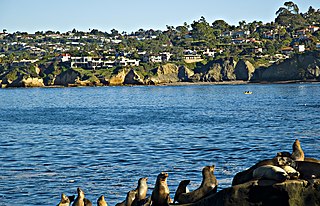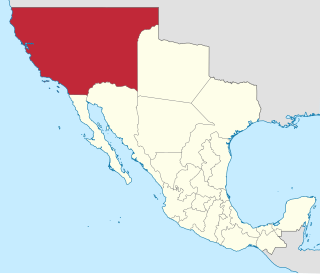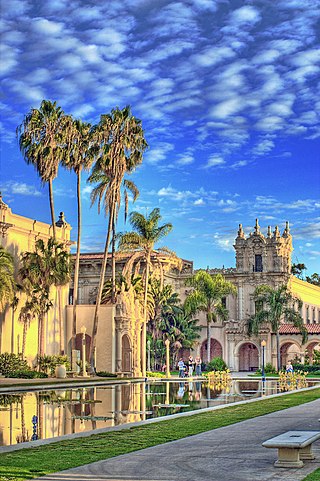
San Diego is a city in the U.S. state of California located alongside the Pacific Ocean in Southern California. With a population of over 1.3 million residents, the city is the eighth-most populous in the United States and the second-most populous in California after Los Angeles. The city is located immediately adjacent to the Mexico–United States border and is the seat of San Diego County, which has a population of nearly 3.3 million people as of 2021. San Diego is known for its mild year-round Mediterranean climate, extensive beaches and parks, its long association with the United States Navy, and its recent emergence as a healthcare and biotechnology development center.

Juan Bautista de Anza Bezerra Nieto was an expeditionary leader, military officer, and politician primarily in California and New Mexico under the Spanish Empire. He is credited as one of the founding fathers of Spanish California and served as an official within New Spain as Governor of the Province of New Mexico.

Mission Basilica San Diego de Alcalá was the second Franciscan founded mission in The Californias, a province of New Spain. Located in present-day San Diego, California, it was founded on July 16, 1769, by Spanish friar Junípero Serra, in an area long inhabited by the Kumeyaay people. The mission and the surrounding area were named for the Catholic saint Didacus of Alcalá, a Spaniard more commonly known as San Diego. The mission was the site of the first Christian burial in Alta California. The original mission burned in 1775 during an uprising by local natives. San Diego is also generally regarded as the site of the region's first public execution, in 1778. Father Luis Jayme, California's first Christian martyr who was among those killed during the 1775 uprising against the mission, lies entombed beneath the chancel floor. The current church, built in the early 19th century, is the fifth to stand on this location. The mission site is a National Historic Landmark.

Alta California, also known as Nueva California among other names, was a province of New Spain formally established in 1804. Along with the Baja California peninsula, it had previously comprised the province of Las Californias, but was made a separate province in 1804. Following the Mexican War of Independence, it became a territory of Mexico in April 1822 and was renamed Alta California in 1824.

Gaspar de Portolá y Rovira was a Spanish military officer, best known for leading the Portolá expedition into California and for serving as the first Governor of the Californias. His expedition laid the foundations of important Californian cities like San Diego and Monterey, and bestowed names to geographic features throughout California, many of which are still in use.

The Kumeyaay, also known as 'Iipai-Tiipai or by the historical Spanish name Diegueño, is a tribe of Indigenous peoples of the Americas who live at the northern border of Baja California in Mexico and the southern border of California in the United States. They are an indigenous people of California.

Mission Valley is a wide river valley trending east–west in San Diego, California, United States, through which the San Diego River flows to the Pacific Ocean. For planning purposes the city of San Diego divides it into two neighborhoods: Mission Valley East and Mission Valley West.

Sorrento Valley is a neighborhood of San Diego, California. It is located about 17 mi (27 km) north of Downtown San Diego and its main airport, Lindbergh Field. It is roughly bounded by Interstate 5 and Interstate 805, Camino Santa Fe to the east, the Los Peñasquitos Canyon Preserve to the north and Miramar Road to the south, as shown on the San Diego Police Department's neighborhood map. It encompasses Sorrento Mesa and is part of the San Diego Unified School District.

Carmel Valley is a suburban planned community in the northwestern corner of San Diego, California, United States. The community is composed of commercial offices, residential units, hotels, retail stores and restaurants.

El Presidio Real de San Diego is a historic fort in San Diego, California. It was established on May 14, 1769, by Gaspar de Portolá, leader of the first European land exploration of Alta California—at that time an unexplored northwestern frontier area of New Spain. The presidio was the first permanent European settlement on the Pacific Coast of the present-day United States. As the first of the presidios and Spanish missions in California, it was the base of operations for the Spanish colonization of California. The associated Mission San Diego de Alcalá later moved a few miles away.
José Francisco Ortega was a Spanish soldier and early settler of Alta California. He joined the military at the age of twenty-one and rose to the rank of sergeant by the time he joined the Portola expedition in 1769. At the end of his military duty he would be granted land which he named Rancho Nuestra Senora del Refugio near Santa Barbara.

The written history of the San Diego, California, region began in the present state of California when Europeans first began inhabiting the San Diego Bay region. As the first area of California in which Europeans settled, San Diego has been described as "the birthplace of California."

Fernando Javier Rivera y Moncada was a Mexican-born soldier of the Spanish Empire who served in The Californias, the far north-western frontier of New Spain. He participated in several early overland explorations and later served as third Governor of The Californias, from 1774–1777.
Kumeyaay (Kumiai), also known as Central Diegueño, Kamia, 'Iipay Aa, and Campo, is the Native American language spoken by the Kumeyaay people of southern San Diego and Imperial counties in California as well as five Kumiai communities in Baja California Norte, MX.
Luis Jayme or Lluís Jaume O.F.M., born Melcior Jaume Vallespir, was a Spanish-born Roman Catholic priest of the Franciscan Order. He was the first Catholic martyr who died in Alta California.

Presidio Park is a city historic park in San Diego, California. It is the site where the San Diego Presidio and the San Diego Mission, the first European settlements in what is now the Western United States, were founded in 1769.
North City is a neighborhood in San Diego, California bordered by Solana Beach and Rancho Santa Fe to the north, Del Mar Heights to the west, and Carmel Valley to the south. I-5 forms the western boundary. The name is almost never used by local residents as the area is already included in either Rancho Santa Fe or Carmel Valley. The name is almost exclusively used by the San Diego Police Department for zoning.
The following is a timeline of the history of the city of San Diego, California, United States.
Miguel Costansó (1741–1814), original name Miquel Constançó, was a Catalan engineer, cartographer and cosmographer. He joined the expedition of exploration of Alta California led by Gaspar de Portolá and Junípero Serra, serving aboard ship as cartographer and on land as engineer.

















